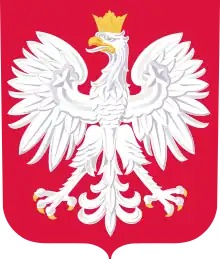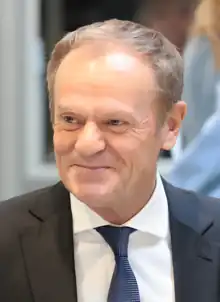| |||||||||||||||||||||||||||||||||||||
All 460 seats in the Sejm 231 seats needed for a majority in the Sejm All 100 seats in the Senate | |||||||||||||||||||||||||||||||||||||
|---|---|---|---|---|---|---|---|---|---|---|---|---|---|---|---|---|---|---|---|---|---|---|---|---|---|---|---|---|---|---|---|---|---|---|---|---|---|
| |||||||||||||||||||||||||||||||||||||
| |||||||||||||||||||||||||||||||||||||
 |
|---|
Parliamentary elections will be held in Poland on or before 11 November 2027 to elect members of the Sejm and Senate, although they can be held sooner if a snap election is called. The last snap election was in 2007. The previous elections in 2023 saw the Law and Justice party win the most seats but fail to win a majority of seats, with a coalition government led by Donald Tusk formed.
Electoral system
The process of election for the Sejm is through party-list proportional representation via the D'Hondt method in multi-seat constituencies,[1] with a 5% threshold for single parties and 8% threshold for coalitions (requirements waived for national minorities).
The date of the election will be set by the President of Poland. If the election isn't snap, it has to take place within 30 days before the expiration of the current term and fall on a non-working day. The possible dates are:
- 17 October 2027 (Sunday)
- 24 October 2027 (Sunday)
- 31 October 2027 (Sunday)
- 1 November 2027 (All Saints' Day)
- 7 November 2027 (Sunday)
- 11 November 2027 (National Independence Day)
Political parties
Law and Justice has been in power between 2015 and the 2023 Polish parliamentary election and was the leading party of government from 2005 to 2007. United Poland and Kukiz'15 have also been a part of the government and collectively they are known as the United Right. PiS is the largest member of the European Conservatives and Reformists (ECR) group.
Civic Coalition is a coalition made up of the Civic Platform, Modern, Polish Initiative, and the Greens. The PO has been Poland's second largest political party since 2015 and the main opposition to Law and Justice. They were the leading party of government from 2007 to 2015 and are members of the European People's Party Group (EPP Group).
Third Way is a centrist to centre-right, Christian democratic coalition. It is made up of the Polish People's Party, which served in all government coalitions since 1989, except those led by Law and Justice (2005–2007 and 2015–present), and AWS (1997–2001), as well as Poland 2050 which is a new party led by media personality Szymon Hołownia who aims to "bring normality back to politics" in a more green conservative manner. TD is a coalition of members of Renew Europe (Poland 2050) and European People's Party Group (PSL).
New Left is composed of social liberals, social democrats and democratic socialists, last of which is represented by a separate party, Left Together. The alliance's main predecessor, Democratic Left Alliance has been in government coalitions twice: first time in 1993, second in 2001. NL is a member of the Socialists and Democrats (S&D) group.
Confederation is a de-jure party but de-facto coalition of the National Movement, New Hope, the Crown and other minor right-wing parties. They are not members of any pan-European group. They are a mixture of hard libertarian parties as well as nationalist anti-immigrant parties.
Opinion polls

References
- ↑ "Election Resources on the Internet: Elections to the Polish Sejm, Part I". electionresources.org. Retrieved 2014-08-03.
.jpg.webp)




.jpg.webp)
.png.webp)